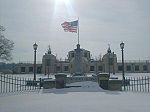Goodyear Airdock
Aircraft hangars on the National Register of Historic PlacesAirships of the United StatesBuildings and structures in Akron, OhioGoodyear Tire and Rubber CompanyHistoric American Engineering Record in Ohio ... and 5 more
Historic Civil Engineering LandmarksIndustrial buildings and structures on the National Register of Historic Places in OhioNational Register of Historic Places in Summit County, OhioTransport infrastructure completed in 1929Transportation in Akron, Ohio

The Goodyear Airdock is a construction and storage airship hangar in Akron, Ohio. At its completion in 1929, it was the largest building in the world without interior supports.
Excerpt from the Wikipedia article Goodyear Airdock (License: CC BY-SA 3.0, Authors, Images).Goodyear Airdock
Triplett Boulevard, Akron
Geographical coordinates (GPS) Address Website Nearby Places Show on map
Geographical coordinates (GPS)
| Latitude | Longitude |
|---|---|
| N 41.031944444444 ° | E -81.470833333333 ° |
Address
Akron Fulton International Airport
Triplett Boulevard 1600
44306 Akron
Ohio, United States
Open on Google Maps






